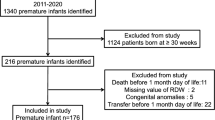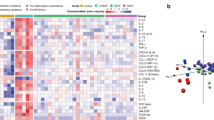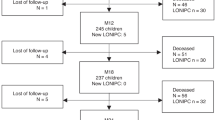Abstract
OBJECTIVE:
This study was designed to determine the effect of dexamethasone treatment on peripheral blood lymphocyte counts and subpopulations in premature infants with bronchopulmonary dysplasia (BPD).
STUDY DESIGN:
Peripheral blood lymphocyte subpopulations in 12 premature infants with BPD were analyzed before treatment with a 6-week course of dexamethasone (day 0), on days 3 and 10 of treatment, and 2 weeks after discontinuing dexamethasone therapy (day 56). Lymphocyte immunophenotypes were determined using direct two-color immunofluorescent staining followed by flow cytometry.
RESULTS:
The percentage of lymphocytes was significantly lower on days 3 (17.55 ± 2.55) and 10 (20 ± 11.8) of dexamethasone therapy compared with before (30.36 ± 6.41) or after treatment. The percentage of T cells was significantly lower on days 3 and 10 of dexamethasone therapy (mean ± SEM; 58.09 ± 1.93 and 60.09 ± 2.47, respectively) compared with before (67.09 ± 4.24) or after treatment. The absolute number of T cells was significantly lower on day 10 of therapy. The percentage of CD4+ cells was significantly lower on days 3 (38.91 ± 2.49) and 10 (40.45 ± 2.24) of therapy, and this decrease persisted after dexamethasone was stopped (36.73 ± 3.41). The absolute number of CD4 cells was significantly lower on day 10 (1328 ± 216) of therapy and reached a nadir on day 56 (1143 ± 106). Similarly, the CD4/CD8 ratio was also significantly lower on days 3 and 10 of treatment (1.56 ± 0.18 and 1.64 ± 0.14, respectively) and reached a nadir on day 56 (1.04 ± 0.13).
CONCLUSION:
Dexamethasone significantly reduced the percentage and absolute number of lymphocytes, T cells, and CD4 cells, as well as the CD4/CD8 ratio. A
reduction in CD4 cells and in the CD4/CD8 ratio persisted 2 weeks after dexamethasone therapy was stopped. In contrast, the absolute number of B cells increased transiently, and CD8 cells were unaffected by dexamethasone. This alteration in lymphocyte subpopulations may help account for the clinically beneficial anti-inflammatory effect of dexamethasone in the treatment of BPD complicated by respiratory failure. The dexamethasone-induced decrease in CD4 cells may also increase the susceptibility of these infants to infection.
This is a preview of subscription content, access via your institution
Access options
Subscribe to this journal
Receive 12 print issues and online access
$259.00 per year
only $21.58 per issue
Buy this article
- Purchase on Springer Link
- Instant access to full article PDF
Prices may be subject to local taxes which are calculated during checkout
Similar content being viewed by others
Author information
Authors and Affiliations
Rights and permissions
About this article
Cite this article
Parimi, P., Birnkrant, D., Rao, L. et al. Effect of Dexamethasone on Lymphocyte Subpopulations in Premature Infants with Bronchopulmonary Dysplasia. J Perinatol 19, 347–351 (1999). https://doi.org/10.1038/sj.jp.7200201
Published:
Issue Date:
DOI: https://doi.org/10.1038/sj.jp.7200201
This article is cited by
-
Inflammatory Mediators in the Immunobiology of Bronchopulmonary Dysplasia
Clinical Reviews in Allergy & Immunology (2008)
-
Dexamethasone Therapy and Candida Sepsis in Neonates Less Than 1250 Grams
Journal of Perinatology (2002)



